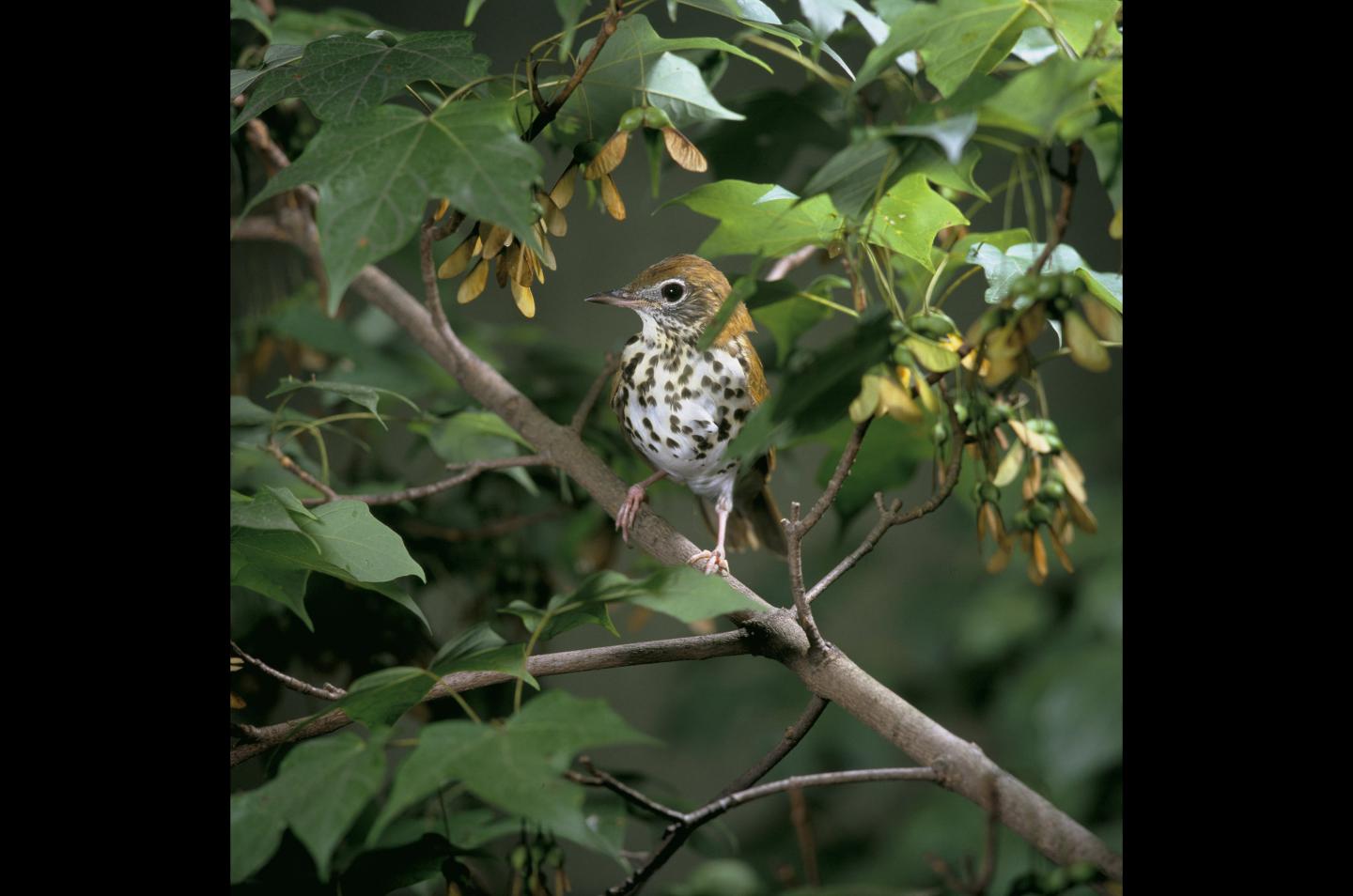
Credit: Photo by Steve Maslowski, US Fish and Wildlife Service (Public domain).
Before cutting down forest, land managers in drought prone areas might first consider the birds in the trees.
According to a new study by biologists at Virginia Tech and the Smithsonian Migratory Bird Center, the offspring of a certain songbird, the wood thrush, are more likely to survive drought in larger forest plots that offer plenty of shade and resources.
These results were published Oct. 18 in The Auk: Ornithological Advances, a journal of the American Ornithological Society.
Wood thrush are common to the United States, but populations have declined by more than 60 percent since the 1960s. In addition, many species of songbirds, such as blue jays, robins, and cardinals, as well as wood thrush, face the highest risk of dying within the first five days of leaving their nests.
A team of Smithsonian biologists led by Brandt Ryder worked closely with Ben Vernasco, a doctoral candidate in biology at Virginia Tech, on a study that aimed to identify characteristics that promote healthy wood thrush populations on U.S. Department of Defense land. Vernasco specifically worked to determine the factors affecting wood thrush survival during the post-fledgling period–the stage lasting about 21 days until baby birds become independent.
From 2011-2014, the team tracked the birds' movements and their habitats during breeding from April to August across 12 locations in southern Indiana. The sites–including locations in the Crane Naval Surface and Warfare Center, Big Oaks National Wildlife Refuge, and state parks–varied in habitat size and form, ranging from small to large forest fragments with varying degrees of tree cover.
In 2012, during the team's investigation, a summer drought hit the Midwest and Northern Plains. Agriculture in the region was impacted such that the U.S. Department of Agriculture declared more than 1,000 counties in 26 states natural disaster areas as rainfall dropped an average of roughly 26 inches down to just over 13. Minor winter storms the previous year contributed to less snowfall, drier soil, and recorded temperatures of more than 30 degrees Fahrenheit higher in some states than in summer 2011.
According to the recent study, first authored by Vernasco, post-fledgling wood thrush survival is highest in small forest fragments, a result supported by previous work that found nestlings grow faster closer to forest edges, which were also found to have dense vegetation that protects fledglings from predators. During the drought, however, the birds had lower survival. The dry conditions, the researchers suspect, reduce available food resources, leaving the young birds more susceptible to starvation and predation.
Birds in larger mature forest areas, on the other hand, were better able to withstand the dry conditions since these areas offer more shade and resources. Forest cover helps maintain climatic conditions, including moist soil, which is an important factor for wood thrush food availability. These conditions ultimately make areas more resilient to drought.
"The research highlights the role that forest cover can play in buffering animals from stressful environmental conditions – in this case, promoting survival of young birds during drought conditions," said Amanda Rodewald, professor and director of conservation science at the Cornell Lab of Ornithology, who was not involved with the research. "This finding is yet another that underscores the importance of maintaining forested landscape mosaics in strategies to conserve biodiversity."
For ideal survival, then, Vernasco says fledglings do well with a "mosaic" of habitats made up of forests that differ in age and thus vegetation structure. However, wood thrush populations are sensitive to forest fragmentation, which tends to come from agriculture and clear cutting.
Wood thrush are a flagship species, meaning they are charismatic and often studied as representative of other species, so knowledge learned about them can likely apply to other forest songbirds, said Vernasco.
###
The post-fledgling period has historically been understudied since tracking movements and following fledgling songbirds over long periods of time and space is difficult. For this study, the biologists were able to track the birds' movement by applying colored bands on their legs and outfitting them with tiny backpacks that emit radio signals yet weigh less than a paper clip.
Since the development of high frequency radio transmitters, this study is one of the longest and also has one of the largest sample sizes, with 210 birds, focused on the post-fledgling stage.
Vernasco got involved in the project as a field technician just after receiving a degree in applied vertebrate ecology in 2013 from Humboldt State University. He is now co-advised by Ryder and Ignacio Moore, a professor of biological sciences in the College of Science at Virginia Tech.
Vernasco is a fellow in Interfaces of Global Change, the graduate program of the Global Change Center at Virginia Tech, which is an arm of the Fralin Life Science Institute.
Media Contact
Lindsay Key
[email protected]
540-231-6594
@vtnews
http://www.vtnews.vt.edu





